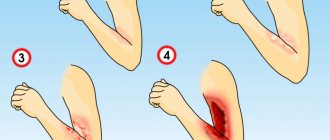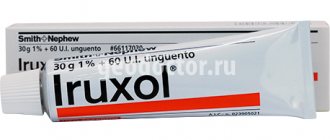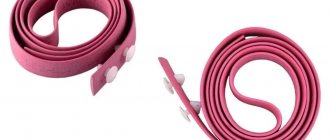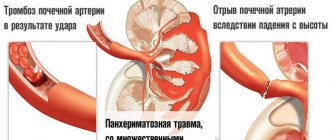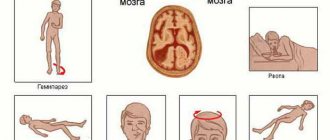Quickly and correctly provided first aid for bleeding is the key to a successful recovery of the victim.
The first aid algorithm depends on the type of bleeding. There are 4 types:
| Arterial | Represents the greatest danger. The blood flows quickly and is scarlet in color. |
| Venous | The blood flows out more slowly and is dark red in color. |
| Capillary | The blood comes out slowly and in a small volume, and has a bright red color. It may appear as small red drops on a person's skin. |
| Internal | The danger of this type of bleeding is that it is quite difficult to determine its presence in a person. Symptoms of internal bleeding depend on its location, most often the person becomes weak and pale, his pulse quickens (up to 140/min), he feels dizzy, has weak breathing, a swollen painful abdomen in the “embryo” position, and there may be a bruise on the abdomen. |
Emergency care for arterial bleeding
Remember that in case of arterial bleeding you cannot hesitate!
Quickly assess the situation and proceed to provide assistance. First of all, pinch the artery with your finger:
If bleeding is in the face area, press your finger on the corner of the lower jaw.
If bleeding is from the head area, then press your finger on the temporal bone in front of the ear.
If bleeding is in the area of the shoulder joint, then press the subclavian artery to the rib.
If bleeding is in the area of the hand, then press the brachial artery to the bone from the side of the shoulder.
If there is bleeding in the thigh area, then you need to press your fist on the frontal bone in the groin area.
Next you need to apply a tourniquet. To temporarily stop arterial bleeding, an Esmarch tourniquet or improvised rubber material is used. Rules for applying a tourniquet:
- Raise, if possible, the victim's arm/leg - this will lead to the outflow of venous blood from the limb;
- Place the tourniquet over the victim’s clothing or a piece of fabric: this is necessary so as not to injure the person’s skin.
- The first 2 turns need to be made the tightest, the crosshair is applied on the back side of the artery. Make sure that the bleeding from the wound has stopped and the skin below the tourniquet has turned pale.
- The victim should be immediately sent to the hospital or call an ambulance.
If you do not achieve complete disappearance of the pulse on the radial artery, then within 10-15 minutes the hand will swell and turn blue. Then the tourniquet can be removed only if the arm is amputated. Record the time of application of the tourniquet. The maximum permissible time in summer is 90 minutes, in winter – 60 minutes, otherwise tissue necrosis occurs.
Every 30-40 minutes, regardless of the time of year, you should remove the tourniquet for 20-30 seconds (until the skin below its application turns pink). This is done so that blood can enter the damaged limb to supply it with oxygen and remove metabolic products.
Then the tourniquet should be applied again below or above its previous location. You can do this for several hours.
General rules of first aid for bleeding
If the victim has lost a significant amount of blood, try to lay him down and elevate his legs.
Do not touch the wound with your hands or remove glass shards from it.
If sand and rust get into the wound, do not wash the damage, as this will increase the bleeding.
If the wound becomes dirty, you need to carefully remove the dirt in the direction from the wound, then treat the cleaned edges with an antiseptic.
When treating the edges of a wound with an iodine solution, do not allow the antiseptic to get inside the wound.
Depending on the type of blood loss, try to stop the bleeding using a tourniquet, twisting, or squeezing the damaged vessel.
First aid for capillary bleeding
Bleeding from the capillaries is not accompanied by large blood loss and stops relatively quickly. A sign of capillary damage is the appearance of a gentle stream of blood on the wound.
First aid for this bleeding includes treating the edges of the wound with an alcohol antiseptic (iodine), on which an aseptic gauze bandage is applied. Please note that the bandage is not tight. Usually, with capillary bleeding, there is no need to go to the hospital, with the exception of situations where the damage is extensive.
1 First aid for bleeding
2 First aid for bleeding
3 First aid for bleeding
First aid for venous bleeding
A sign of venous bleeding is rapidly flowing dark blood. Its flow is uniform, without gushing or pulsating.
With venous bleeding, blood clots may appear; they cannot be removed, since in this case blood loss may increase.
To stop bleeding, apply a pressure aseptic bandage to the wound. If blood loss continues, it is necessary to apply a tourniquet below the damaged area. To reduce injury to soft tissues and skin, a soft pad is placed on them (under the tourniquet). It is necessary to make a note indicating the time of application of the tourniquet. The maximum time for wearing a tourniquet is 2 hours in warm weather and 1 hour at sub-zero temperatures. The tourniquet cannot be held longer than this time, otherwise the bloodless tissue will begin to die. If you don’t have a tourniquet, you can make twists from available materials: a bandage, a belt, a towel, a piece of fabric using a handle and a short stick. The time frame for the spins is the same. Try not to use any hemostatic drugs without a doctor's prescription.
First aid for arterial bleeding
Arterial bleeding is one of the most dangerous. The main sign of arterial damage is bright scarlet blood flowing out in a pulsating stream at high speed. If large arteries are damaged, the blood begins to flow intermittently, like a fountain.
First aid for this bleeding is to apply a hemostatic tourniquet above the level of the wound. You can also use a twist. Time restrictions are the same.
If there is no tourniquet or twist, you can stop the bleeding by pressing the artery above the damaged area with your finger, i.e. at the pulsation point.
In case of bleeding from the brachial, ulnar, femoral or popliteal artery, you can fix the arm or leg as bent as possible in an elevated position.
First aid for venous bleeding
With venous bleeding, a stream of blood comes to the surface at high speed so that it does not allow a blood clot to form and stop the bleeding.
As a result, a person may lose a large amount of blood.
Algorithm for providing assistance:
- Raise the injured limb upward;
- Cover the wound with a bandage or clean cloth folded several times;
- Cover the wound tightly with a bandage.
In case of severe venous bleeding, a tourniquet is applied and then cold is applied to the wound. Next, go to the hospital for help.
First aid for bleeding
Aibolit First aid First aid for bleeding
Bleeding is the loss of blood when the integrity of blood vessels is disrupted. The type of first aid depends on the type of bleeding.
Blood during arterial bleeding is bright red and “spouts like a fountain” from the wound. In this case, the victim feels severe pain at the site of injury.
To provide first aid for arterial bleeding, you must:
- Firmly press the artery with your finger slightly above the site of injury;
- Apply a tourniquet 5 cm above the injury site;
- Apply a compressive bandage to the wound;
With venous bleeding, the blood has a dark burgundy color and flows out of the wound in a non-pulsating stream. First aid for this type of bleeding should be provided as quickly as possible. The bleeding can be stopped using a special tourniquet, after which the victim, who is in a horizontal position, must be immediately taken to the hospital.
Capillary bleeding is damage to the walls of the smallest vessels, capillaries. Its distinguishing feature is that blood seeps out over the entire surface of the wound. To stop the bleeding, a tight pressure bandage must be applied to the wound, although capillary bleeding often stops on its own after a few minutes.
All mentioned types of bleeding were considered superficial, but the greatest danger to human life is internal bleeding. With it, blood from damaged blood vessels does not leave the muscle and skin of the body. Only capillary internal bleeding, which forms subcutaneous hematomas - bruises, is not dangerous. And internal venous and arterial bleeding can lead to irreparable consequences for the health of the victim.
Signs of internal bleeding:
- Formation of a large bruise at the site of injury;
- Nausea and vomiting;
- Coughing up blood;
- Decreased blood pressure;
- Weak but rapid pulse;
- Rapid breathing;
- Feeling thirsty;
- The skin of the body takes on a pale, grayish tint and becomes damp and cold to the touch.
If internal bleeding occurs, call a doctor immediately. While the ambulance is on the way, you can relieve the pain of the victim by applying cold (ice pack) to the injured area, taking breaks every 15 minutes. You can apply gentle pressure to the injured area to ease the bleeding a little.
Emergency care for capillary bleeding
With capillary bleeding, an infection can enter the human body through the wound. To prevent this from happening, the wound must be treated and bandaged.
Algorithm for providing assistance:
- If the wound is dirty, it should be washed with water;
- Treat the wound with hydrogen peroxide;
- Apply a bandage to the wound or place an antibacterial patch over the wound.
Nosebleeds can stop on their own, but in severe cases first aid must be provided:
- Sit the victim down with his head slightly forward and let the blood drain.
- Apply cold (ice, cold pack, etc.) to the bridge of your nose.
- Press the wing of your nose against the nasal septum - the bleeding should stop within 10 minutes.
- If this does not happen, rolled gauze swabs must be placed in the nasal cavity. If bleeding in this case continues after 10 minutes, send the victim to the hospital.
How to stop capillary bleeding?
Timely first aid for capillary bleeding contributes to its temporary or complete cessation. Methods to stop bleeding depend on its intensity and include applying a pressure bandage, tamponade, and applying cold. In most cases, such bleeding does not cause extensive blood loss, but it is dangerous due to infection with pathogenic bacteria.
If a wound occurs on an arm or leg, assistance should be provided as follows:
- Raise the injured limb above the level of the heart - the pressure in the vessels decreases, which leads to stopping or significantly reducing bleeding;
- If a small area is wounded, to prevent infection it is necessary to lubricate the skin around the wound with iodine or treat it with 3% hydrogen peroxide. For faster healing, a bactericidal patch is fixed on top;
- Apply a pressure bandage in several layers with a bandage or gauze. Bandaging must be done from the bottom up, after two layers of bandage, apply a cotton swab and continue bandaging. If the bandage becomes saturated with blood, there is no need to remove the bandages; several more layers should be applied on top;
- With an extensive wound, maximum flexion of the joint located above the wound helps to temporarily stop bleeding, but the most reliable way is to apply a tourniquet. This is done like this: as close as possible to the wound, but above it, you must place a cloth or bandage, tighten a tourniquet on top and be sure to place a note under it with the exact time of application. In winter, the tourniquet is kept for no longer than an hour, in summer no longer than one and a half. After this time, it is necessary to loosen the tourniquet for 15 minutes and tighten it again;
- To reduce pain and stop bleeding, apply an ice pack to the wound.
First aid for internal capillary bleeding in the abdominal cavity: lay the patient on his back, raise his legs and throw back his head, apply ice to the site of suspected bleeding and call an ambulance. Such actions help prevent shock, but under no circumstances should you delay going to a medical facility!
Nosebleeds - how to stop?
The nasal mucosa is rich in tiny capillaries, so any injury can cause bleeding. They are distinguished by duration and intensity. Often, bleeding from the nose begins to bleed for no apparent reason, but usually such bleeding is caused by a blow, prolonged use of vasoconstrictor drops in the nose, fragility and weakness of blood vessels, sun or heatstroke, hypertension or anatomical defects of the nasal cavity.
- Providing first aid for capillary nosebleeds is very simple, it is only important to do everything correctly:
- The patient should be in an upright position, preferably sitting, with the head slightly tilted forward. This ensures unimpeded flow of blood from the nostrils. You can’t throw your head back, because blood flowing into the nasopharynx can cause vomiting or coughing, and this will only increase bleeding;
- Apply ice to the nose area;
- Press the wings of the nose against the septum for five minutes. This promotes the formation of a blood clot;
- Place a swab soaked in a solution of 3% hydrogen peroxide into the nasal passage.
It is advisable to perform all procedures with rubber gloves, or at least pre-disinfect your hands. If you have frequent nosebleeds, you need to take regular preventive measures, strengthen blood vessels, take ascorutin or ascorbic acid.
Danger of nosebleeds
A condition in which blood is released from the nasal cavity can be life-threatening if the cause is a serious illness or injury. It is necessary and very important to temporarily stop bleeding before arriving at the hospital. If the nose bleeds for more than half an hour and is not stopped by the methods described above, and the volume of blood loss is more than 200 ml, you need to call an ambulance, regardless of the suspected causes of the bleeding.
Author of the article:
Alekseeva Maria Yurievna |
Therapist Education: From 2010 to 2021 practicing physician at the therapeutic hospital of the central medical unit No. 21, the city of Elektrostal. Since 2021 he has been working at diagnostic center No. 3. Our authors
